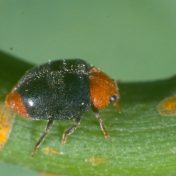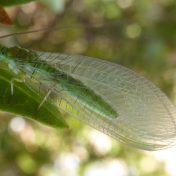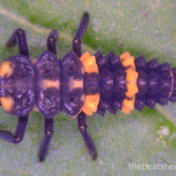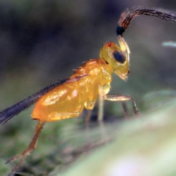Cryptolaemus montrouzieri is a ladybird beetle native to Australia that feeds predominately on mealybug and soft scale insects. Identified as an effective biological control agent, it has been exported to many other regions, and is reared commercially for control of a range of mealybug species, particularly in horticultural crops. In cotton crops where solenopsis mealybug (Phenacoccus solenopsis) is present, Cryptolaemus… Read more »
Green lacewing larvae are generalist predators, and are important natural enemies of a range of pests including aphids, helicoverpa, whitefly and mealybugs. There are many species of green lacewings in Australia, including some that commonly occur in field crops. Readers are most likely to be familiar with Mallada signatus, which regularly features in ID guides, but another species, Plesiochyrsa ramburi… Read more »
Adult ladybird beetles are one of the most easily recognisable natural enemies in cropping systems. Both adults and larvae are voracious predators, and can have a considerable impact on pest populations, particularly aphids. Several species of ladybird beetles are commonly encountered each year in grain, pulse and cotton crops. Ladybirds are often attracted into crops by the presence of aphids,… Read more »
Of importance to agronomists is how pest populations are changing over time and the likely impact predators will have on the pest population. Predator and parasitoid activity can be difficult to assess under field conditions, particularly the rate at which beneficials can find pest species. In this research, sentinel prey were used to gauge the level of natural predator and… Read more »
The tiny wasp Eretmocerus hayati is an important natural enemy of silverleaf whitefly (SLW) and contributes to the natural biological control of this pest throughout the season. It occurs in almost all regions that grow cotton, but due to its small size (difficult to see without a hand lens) it often goes unnoticed. Like all natural enemies, Eretmocerus is susceptible… Read more »
The minute two-spotted ladybird beetle (Diomus notescens) and the transverse ladybird beetle (Coccinella transversalis) are two natural enemies of cotton aphid (Aphid gossypii). They are commonly found in Australian crops, however relatively little is known about their biology. A series of laboratory experiments were conducted by the Queensland Department of Agriculture and Fisheries (DAF) to learn more about aspects of… Read more »
We have fielded numerous enquiries this week from consultants who would like to assess levels of whitefly parasitism. This is achievable in the field with the use of a hand lens. Parasitism levels appear to be a little down from last year, but still good levels have been recovered. Parasitism so far has ranged from 50-90% in Emerald, 35% in… Read more »
Microplitis demolitor is just one of many friendly fighters that battle to contain numbers of one of our most important pests, the corn earworm, Helicoverpa armigera. Corn earworm on grain sorghum is making its presence felt and many crops are being sprayed with Helicoverpa nucleopolyhedrovirus (NPV) to control above-threshold infestations of caterpillars. The current high value of grain sorghum (over… Read more »





